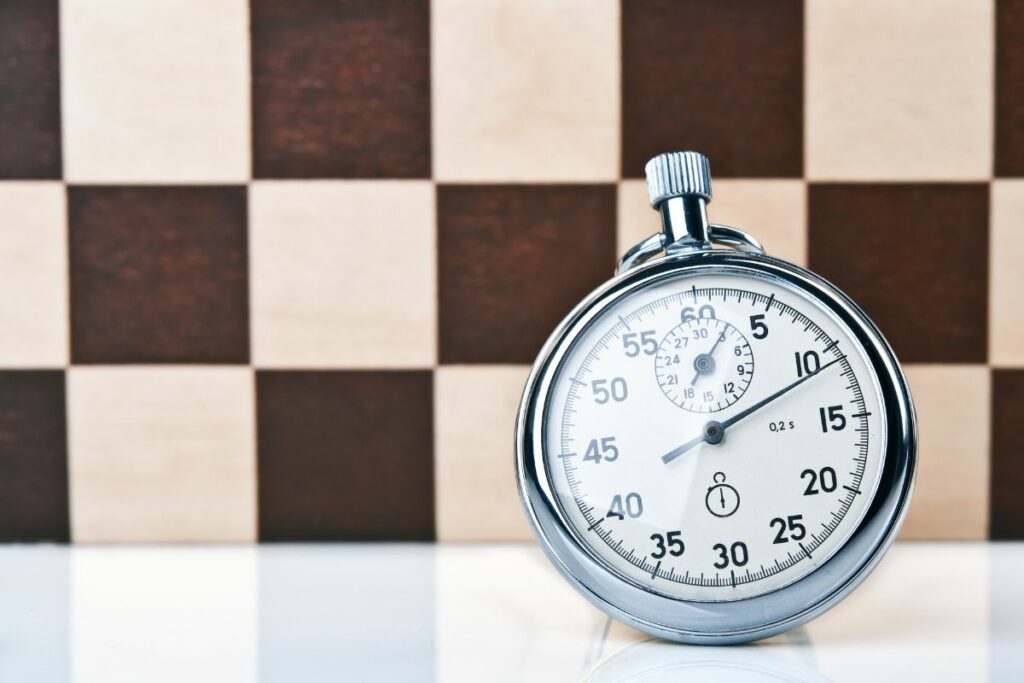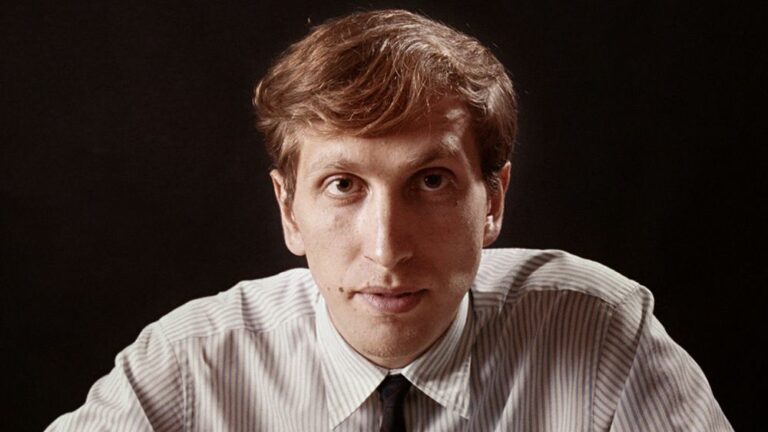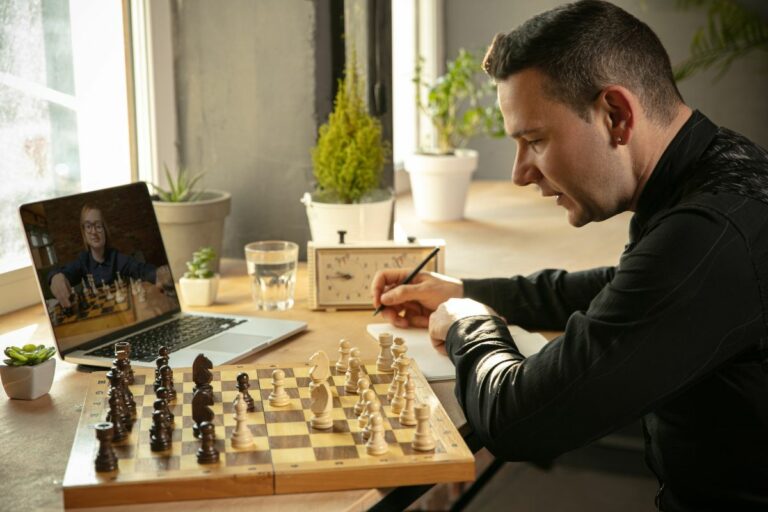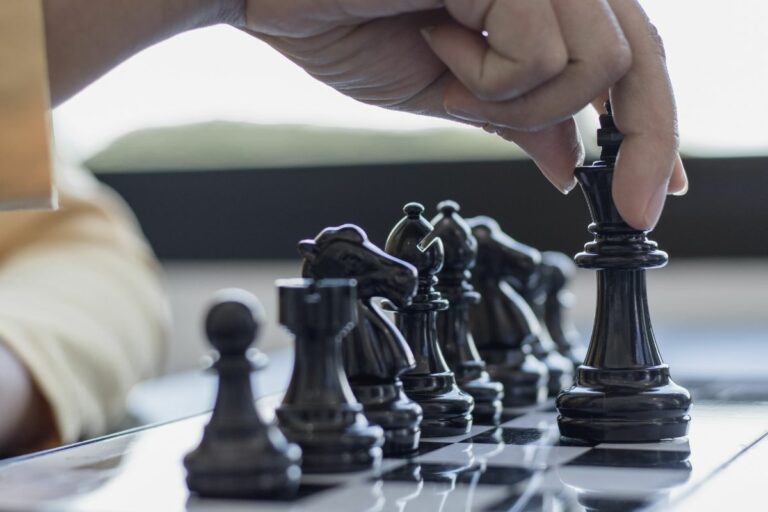How Do Chess Games Last So Long? 4 Time Control Methods Explained
Ever logged in to a live chess website to watch something the World Chess Champion, logged off, and then logged in like 7-8 hours later and found them still playing? Yeah, some chess matches can take many, many hours to finish.
So, how do chess games last so long?
Chess Games can last so long because of the increment each player gets extra time either after a specific number of moves (most common is 30 minutes after 40 moves) or with each move (30 extra seconds with each move). Chess Games can be complicated and players need time to play the best chess they could do.
As you can see, there is quite a bit to this answer, and while the world of time controls in chess can be confusing and bewildering, I’ll try to keep it as simple as possible, so stick around as I do my best to explain why your chess games can often outlast your energy.
How Do Chess Games Last So Long?

If you can’t think clearly, you can’t win a chess game. Chess games take a while to complete because it takes time to find and confirm the optimal move.
It is entirely possible to work on a single move for an hour and yet make mistakes. In an hour-long game, the quality of the moves will be significantly higher than in a blitz 5-minute game.
How Long Do Professional Chess Games Last?
The average professional chess game lasts anywhere between 10 minutes and 6 hours, depending on which time control the game uses. Casual matches end in about 60 minutes. Since classic or standard time control generates the longest games in tournaments, it can last for about 6 or 7 hours.
Is It Possible for a Chess Game to Go on Forever?
Theoretically, chess games can go on forever since there are an infinite number of possibilities and moves. However, in practice, you can’t go on forever just playing one game with no end. The FIDE rules have time controls that allow a player to finish their games in the allocated time.
Why Can’t A Chess Game Last For So Long Today?
Today, chess rules are more attentive to how long chess games last, so they’re not allowed to get “too long.” Chess games can still last for up to 8+ hours in the longest time control (classic), but compared to the past, that’s a lot shorter! So, what happened?
Chess Engines
One of the reasons why this happens is because of how chess engines can now be used to give the best moves scenario for the game to end.
Today, anyone can purchase a powerful engine that can defeat the world champion in one or two games. This means that if a player has the chance to go home after the game, he is most definitely going to analyze his game using an engine and come prepared the following day to play like the engine instructed, which will effectively ruin chess for everyone involved.
We’ll discuss adjournment more later and why it was dropped.
Chess Rules Shift
Time controls have shifted to prevent longer matches by allocating a specific time for each player to finish the game. Some exceptions are made when a player fails to meet this time frame for unusual reasons, but in general, you have to adhere to it not to lose on time.
The prevention of adjourning is another reason why chess games can’t last for so long today. No matter how long it takes for a game to be played, you have to finish it on the same day it starts.
Some new rules are also made to stop chess games from taking forever with no use. The 50-move rule is one of them. In other words, the game ends in a draw if neither player makes a capture or pawn move after 50 moves.
If your opponent cannot checkmate you and you still have a king or a king plus a few pieces, this typically occurs in an endgame.
Time Control in Chess

Time control is a popular term that gets thrown around often when discussing chess rules. Chess time controls describe how much time is given to each player on the board to complete a game.
If a player’s allocated time drops to 0 (ie, they run out of time), they automatically and instantly lose the game regardless of what is going on the board.
Time controls in chess include:
- Classical
- Rapid
- Bullet
- Blitz
Another term that is useful to learn when it comes to understanding time controls is increments. Every time one of the players makes a move in the game of chess, their clock is incremented by a little period of time.
Depending on the time control game you’re playing, it’s normally set between 1 and 30 seconds.
Here is a quick comparison between the 4 Time controls:
| Time Control | Increment (seconds) | Rules | Own Rating |
|---|---|---|---|
| Classic | No increment | Standard FIDE time control (90 minutes for 40 moves then 30 minutes to finish the game) | Yes |
| Rapid | 10-30 seconds | 15-30 minutes per player | Yes |
| Blitz | 3-10 seconds | 3-10 minutes per player | Yes |
| Bullet | No increment | 1 minute per player | No |
Classical Time Control
The World Chess Federation has established a single-time control for all significant FIDE tournaments.
This indicates that each participant is given a typical 90-minute period, which is enough for 40 moves, after which the players will have an additional 30 minutes to finish the game.
Every additional move a player makes gets an extra 30 seconds. This 30 seconds increment is why the chess game can go on and on seemingly forever.
However, some games typically take 120 minutes to complete and involve 40 moves. On the other hand, some games have lasted for 60 minutes for 20 moves, and an additional 15 minutes to finish.
There are various time constraints available when playing chess against the clock. The time limit for serious tournaments is frequently 40 moves in 120 minutes, 20 moves in 60 minutes, and then 30 minutes of sudden death. Thus, a game may go on for up to 7 hours!
So, what’s sudden death? Sudden death is when you must complete the remaining parts of the game before the flag is dropped. A player who fails to finish the games before the flag falls is considered a loser.
Rapid Time Control
Forget about the 60 or 120 minutes you get in classical time control. Rapid chess begins with each player having 30 minutes for the entire game, with some rapid time controls having an extra 10 or 20 seconds increment, and some offering no increment at all.
Blitz Time Control
Coming from its name, which means lightning in German, blitz time control is a very quick type of chess play.
Blitz chess typically has a 5-minute time limit for the entire game. However, the 3-minute blitz is equally well-liked among players. Sometimes you will have a 2 or 3 seconds increment for every move and sometimes you will not. The most popular form of blitz is probably the 5-minute with a 2-second increment.
Bullet Time Control
Without a doubt the fastest form of chess playing. If Blitz isn’t fast enough for you, bullet chess is here to the rescue! All you get is one or two minutes.
No contemplating is allowed. Players enjoy this type of game to practice making fast moves without much thinking. It’s one of the most popular forms on online chess sites.
It’s worth noting that as the time you have is reduced, so does the amount of thinking you can do, which is why almost every professional chess player and coach recommends minimizing the time you play Blitz and Bullet chess, and I discuss why Bullet, in particular, is bad for your chess here.
What is Swiss Time Control?
In chess, the term “Swiss time control” typically refers to a specific time control format used in Swiss-system tournaments. The Swiss system is a popular tournament pairing system that aims to provide players with balanced and fair competition.
However, the Swiss time control itself doesn’t have a fixed definition and can vary depending on the specific tournament or organization.
The most popular form of time control in Swiss formats is 90 minutes+30 seconds increment. In this format, each player gets 90 minutes to finish their games and they get an additional 30 seconds with each move they make.
What Is Adjourning in Chess?

As a chess player, you sure know how tiring it can be, especially if you’ve been playing for a long time in one setting. Fatigue eventually sets in, making it difficult to stay on top of everything. Adjournments were prevalent until the 1990s for exactly this reason.
Depending on the competition, the players’ first session of play lasted anywhere from five to six hours. The game would typically end after five or six hours of play, and players would typically pick it back up the next day.
Of course, a player could request an end to the session at any moment, but doing so would mean giving up the time they had given for that session.
But if no player ran out of time after those five or six hours, the players would be required to adjourn. Anyone who needed to relocate would write down their ideas and place them in a sealed envelope. The envelope is then opened when the game resumes the next day by the arbiter.
Abandoning adjournment
Because chess engines are now used, and the classical format is reduced to account for the shift, adjournments have been abandoned. Even though it was popular in chess as it solved the fatigue problem, adjournment has been no longer possible in tournaments since 1997.
It makes sense to delay the game to tomorrow’s adjournments if neither player can finish their game within the given time, right? But no, even in traditional time constraints, adjournment in chess competitions is no longer common since players may quickly access engines that will suggest the best moves for the situation.
The customary time control was adjusted to 40 moves in 2 hours Plus 20 moves in 1 hour in the middle of the 1980s, considerably lowering the number of adjournments. The last game to involve adjournments was the FIDE World Chess Championship between Karpov and Gata Kamsky in 1996.
If you did find this article helpful, please consider sharing, as it can help this little site grow 🙏







